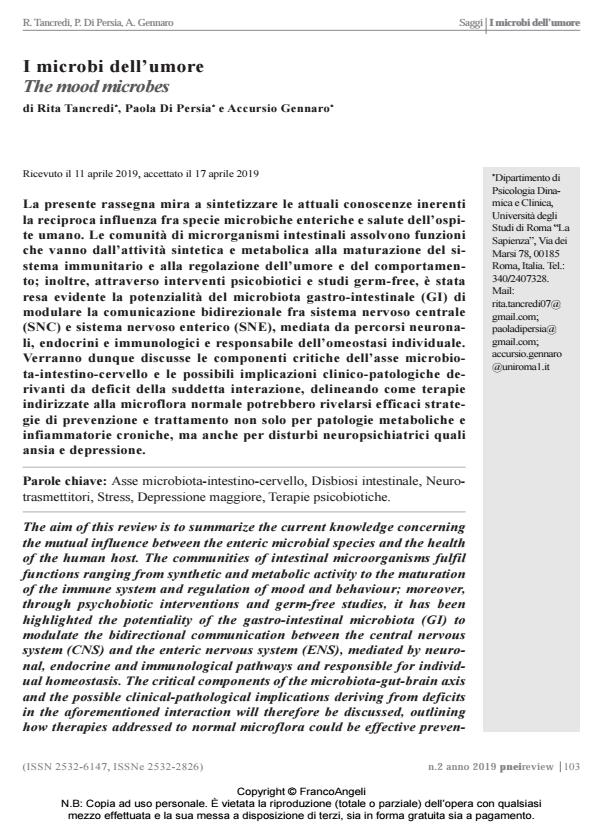I microbi dell’umore
Titolo Rivista PNEI REVIEW
Autori/Curatori Rita Tancredi, Paola Di Persia, Accursio Gennaro
Anno di pubblicazione 2019 Fascicolo 2019/2 Lingua Italiano
Numero pagine 10 P. 103-112 Dimensione file 112 KB
DOI 10.3280/PNEI2019-002010
Il DOI è il codice a barre della proprietà intellettuale: per saperne di più
clicca qui
Qui sotto puoi vedere in anteprima la prima pagina di questo articolo.
Se questo articolo ti interessa, lo puoi acquistare (e scaricare in formato pdf) seguendo le facili indicazioni per acquistare il download credit. Acquista Download Credits per scaricare questo Articolo in formato PDF

FrancoAngeli è membro della Publishers International Linking Association, Inc (PILA)associazione indipendente e non profit per facilitare (attraverso i servizi tecnologici implementati da CrossRef.org) l’accesso degli studiosi ai contenuti digitali nelle pubblicazioni professionali e scientifiche
La presente rassegna mira a sintetizzare le attuali conoscenze inerenti la reciproca influenza fra specie microbiche enteriche e salute dell’ospite umano. Le comunità di microrganismi intestinali assolvono funzioni che vanno dall’attività sintetica e metabolica alla maturazione del sistema immunitario e alla regolazione dell’umore e del comportamento; inoltre, attraverso interventi psicobiotici e studi germ-free, è stata resa evidente la potenzialità del microbiota gastro-intestinale (GI) di modulare la comunicazione bidirezionale fra sistema nervoso centrale (SNC) e sistema nervoso enterico (SNE), mediata da percorsi neuronali, endocrini e immunologici e responsabile dell’omeostasi individuale. Verranno dunque discusse le componenti critiche dell’asse microbiota- intestino-cervello e le possibili implicazioni clinico-patologiche derivanti da deficit della suddetta interazione, delineando come terapie indirizzate alla microflora normale potrebbero rivelarsi efficaci strategie di prevenzione e trattamento non solo per patologie metaboliche e infiammatorie croniche, ma anche per disturbi neuropsichiatrici quali ansia e depressione.;
Keywords:Asse microbiota-intestino-cervello, Disbiosi intestinale, Neurotrasmettitori, Stress, Depressione maggiore, Terapie psicobiotiche.
- Stuart A.L., Hayley A.C., Byrne M.L. and Maes M. (2013). So depression is an inflammatory disease, but where does the inflammation come from?. BMC Med., 11: 200. DOI: 10.1186/1741-7015-11-20
- Bilbo S.D. and Schwarz J.M. (2012). The immune system and developmental programming of brain and behavior. Front. Neuroendocrinol., 33: 267-286.
- Bottaccioli A.G., Bottaccioli F. and Minelli A. (2019). Stress and the psyche-brainimmune network in psychiatric diseases based on psychoneuroendocrineimmunology: a concise review. Ann. N.Y. Acad. Sci., 1437(1): 31-42.
- Capurso L. (2016). Il microbiota intestinale. Recenti Prog. Med., 107:257-266. DOI: 10.1701/2296.2468
- Collins M.D. and Gibson G.R. (1999). Probiotics, prebiotics, and synbiotics: approaches for modulating the microbial ecology of the gut. Am. J. Clin. Nutr., 69: 1052S-1057S.
- Cryan J.F. and O’Mahony S.M. (2011). The microbiome-gut-brain axis: from bowel to behavior. Neurogastroenterol. Motil., 23:187-192.
- Dethlefsen L., McFall-Ngai M. and Relman D.A. (2007). An ecological and evolutionary perspective on human-microbe mutualism and disease. Nature, 449: 811-8.
- Evrensel A. and Ceylan M.E. (2015). The Gut-Brain Axis: The Missing Link in Depression. Clin. Psychopharmacol. Neurosci., 13(3): 239-244.
- FAO/WHO (2001). Health and Nutritional Properties of Probiotics in Food including Powder Milk with Live Lactic Acid Bacteria. -- Testo disponibile al sito: http://www.fao.org/tempref/docrep/fao/meeting/009/y6398e.pdf, visitato il 14/06/2019.
- Foster J.A., Rinaman L. and Cryan J.F. (2017). Stress & the gut-brain axis: Regulation by the microbiome. Neurobiol. Stress, 7: 124-136.
- Gibson G.R., Scott K.P., Rastall R.A., Tuohy K.M., Hotchkiss A., Dubert-Ferrandon A., Gareau M., Murphy E.F.,Saulnier D., Loh G., Macfarlane S., Delzenne N., Ringel Y., Kozianowski G., Dickmann R., Lenoir-Wijnkoop I.,Walker C. and Buddington R. (2010). Dietary prebiotics:current status and new definition. Food Sci. Technol.Bull. Funct. Foods, 7: 1-19. DOI: 10.1616/1476-2137.1588
- Grochowska M., Wojnar M. and Radkowski M. (2018). The gut microbiota in neuropsychiatric disorders. Acta Neurobiol. Exp., 78: 69-81.
- Jiang H., Ling Z., Zhang Y., Mao H., Ma Z., Yin Y., Wang W., Tang W., Tan Z., Shi J., Li L. and Ruan B. (2015). Altered fecal microbiota composition in patients with major depressive disorder. Brain Behav. Immun., 48: 186-194.
- Licht T.R., Ebersbach T. and Frøkiær H. (2012). Prebiotics for prevention of gut infections. Trends Food Sci. Technol., 23: 70-82.
- Logan A.C. and Katzman M.(2005). Major depressive disorder: probiotics may be an adjuvant therapy. Med. Hypotheses, 64: 533-538.
- Lozupone C.A., Stornbaugh J.I., Gordon J.I., Jansson J.K. and Knight R. (2012). Diversity, stability and resilience of the human gut microbiota. Nature, 489: 220-230.
- Lyte M. and Cryan J.F., eds. (2014). Microbial Endocrinology: The Microbiota-Gut-Brain Axis in Health and Disease. New York: Springer-Verlag.
- Marangoni F. e Poli A. (2017). Microbiota intestinale, Probiotici e Salute Umana. Pisa: Pacini Editore Srl. -- Testo diponibile al sito: https://www.pacinimedicina.it/wp-content/uploads/probiotici_w.pdf, visitato il 14/06/2019.
- Messaoudi M., Lalonde R., Violle N., Javelot H., Desor D., Nejdi A., Bisson J.F., Rougeot C., Pichelin M., Cazaubiel M. and Cazaubiel J.M. (2011a). Assessment of psychotropic-like properties of a probiotic formulation Lactbacillus helveticus R0052 and Bifidobacterium longum R0175 in rats and human subjects. Br. J. Nutr., 105: 755-764. DOI: 10.1017/S000711451000431
- Messaoudi M., Violle N., Bisson J.F., Desor D., Javelot H. and Rougeot C. (2011b). Beneficial psychological effects of a probiotic formulation (Lactobacillus helveticus R0052 and Bifidobacterium longum R0175) in healthy human volunteers. Gut Microbes, 2: 256-261.
- Moschetta A. (2018). Il tuo metabolismo. L’utilità della dieta nella prevenzione e cura del cancro. Milano: Mondadori.
- Rieder R., Wisniewski P.J., Alderman B.L. and Campbell S.C. (2017). Microbes and mental health: A review. Brain Behav. Immun., 66: 9-17.
- Schwiertz A., ed. (2016). Microbiota of the Human Body. Implications in Health and Disease. Cham: Springer International Publishing Switzerland.
- Sherwin E., Dinan T.G. and Cryan J.F. (2017). Recent developments in understanding the role of the gut microbiota in brain health and disease. Ann. N.Y. Acad. Sci., 1420: 5-25.
- Tillisch K., Labus J.S., Ebrat B., Stains J., Naliboff B.D., Guyonnet D., Legrain-Raspaud S., Trotin B. and Mayer E.A. (2012). Modulation of the brain-gut axis after 4-week intervention with a probiotic fermented dairy product. Gastroenterol., 142(5 S1): S-115. DOI: 10.1016/S0016-5085(12)60435-
Rita Tancredi, Paola Di Persia, Accursio Gennaro, I microbi dell’umore in "PNEI REVIEW" 2/2019, pp 103-112, DOI: 10.3280/PNEI2019-002010